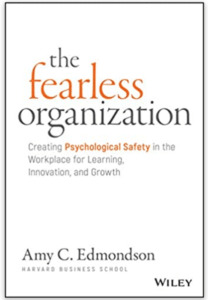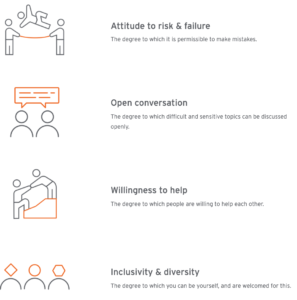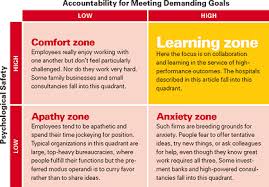 Written in 2019, this book is an excellent extension of Edmondson’s work that I reviewed HERE. I read The Fearless Organization through the lens of change leadership: What might I learn to inform a digital transformation? This book delivers through its use of case studies, self-reflection tools and the Frequently Asked Questions section at the end of the book.
Written in 2019, this book is an excellent extension of Edmondson’s work that I reviewed HERE. I read The Fearless Organization through the lens of change leadership: What might I learn to inform a digital transformation? This book delivers through its use of case studies, self-reflection tools and the Frequently Asked Questions section at the end of the book.
You would be interested in this book if:
1) You were looking to take a deeper look at Psychological Safety in your workplace
2) You were looking for tools to reflect and strengthen your ability to build a Psych-Safe workplace
3) You were looking for data and strategies on Psych Safety in your workplace
4) You were looking for a good read on business performance
Understanding Interpersonal Climate Zones
We now know that psychological safety emerges as a property of a group, and that groups in organizations tend to have very interpersonal climates. Even in a company with strong corporate culture, you will find pockets of both high and low psychological safety. (pg. 8)
Leader can seek out these climate zones and really should. It is up to our leaders, both formal and informal, to be curious about these pockets of high and low zones of psychological safety and ask good questions. “Psychological safety is very much shaped by local leaders.” (pg. 12) Thus, what are we doing to support these local leaders in the skills and strategies to support psychological safety in their climate zone?
Undergoing a digital transformation requires distributed leadership because of the complexity. Having the right tools and communication channels are just two key elements to the toolkit required by leaders at all levels.
Climate Controls:
Moving employees into the Learning Zone is not accomplished easily – it takes emotional labor – while reading this I was thinking of the work of Stuart Shanker and learning to work in harmony with Blue (rationale) and Red (limbic) brains. “High standards in a context where there is uncertainty or interdependence (or both) combined with a lack of psychological safety comprise a recipe for suboptimal performance.” (pg. 19).
And this just isn’t in the hands of the leader. In the book, Edmondson explores “Why silence wins in the Voice-Silence calculation.” Most individuals are always trying to influence how others see them in the workplace, so says Edmondson, and as such, they do mental calculus to determine the costs and benefits of speaking up.
Thus, for leaders, the work is at the organizational and individual level. Google-X is an example that Edmondson cites often and she writes “No mix of personality types of skills or backgrounds emerged that helped explain which teams performed well and which didn’t…What they had discovered was that even the extremely smart, high-powered employees at Google needed a psychologically safe work environment…”(pg. 41)
They also found that the following were key to high performing teams:
1) Clear goals
2) Dependable colleagues
3) Personally meaningful work
4) A belief that the work has impact
But it is psychological safety that underpins these four.
The Leadership Toolkit
“When strategy is seen as a hypothesis to be continually tested, encounters with customers ]employees and clients] provide valuable data of ongoing interest to senior executives.”
This agile approach to strategy can build confidence for people to speak up and be candid about their perspectives. So how do we build the culture to be agile in their approaches?
Looking closely at this chart can take you, as a leader, in a very generative direction. Mostly, it can reframe your role as a leader to the ‘human’ endeavor, and not the bottom-line endeavor. The former gets to the latter far more effectively.
Organizational learning – championed by company leaders but enacted by everyone – requires actively seeking deviations that challenge the assumptions underpinning a current strategy. Then, of course, these deviations must be welcomed because of their informative value for adapting the original strategy. (pg. 71)
I’m processing what this means for me in my role during this digital transformation. How to make transformation welcome in a culture and sector (education) that relies on stability, routine and conservatism?
KEY INSIGHT: In a more conservative culture, where the voice of innovation needs to be the one to speak up and be heard, how might we make the voice of innovation welcomed, explored and sometimes acted upon?
How to Listen and Hear as a Leader
Candour is what the aim of a psychologically safe leader is aiming towards, andthere are great rules to Candour. Such rules allow leaders to understand and set parameters so that psychological safety doesn’t result in not making decisions, or worse, derailing the organization.
Rules of Candour: (From Pixar pg. 106)
1) Feedback must be constructive and specific to the project/initiative
2) Feedback are suggestions, not prescriptions to do something different
3) Feedback must come from a place of empathy, and not be a “Gotcha” moment
Catmull (of Pixar) believes that without the freedom to fail people “will seek instead to repeat something safe that’s been good enough in the past. Their work will be derivative, no innovative. (pg. 108)
Silence and Derivation have their Roots in Schools!
As an educator, I noticed a few remarks in the books about where the mental calculus of Silence vs. Voice comes from. It is through education!
[Catmull] belive that “our society’s mistakephobia is crippling because, beginning in elementary school, we are tuaght to seek the right answer instead of learning to learn from mistakes as a pathway to innovative and independent thinking” (pg. 111)
In schools, we are also taught that learning can be competitive, and so, when we enter in discussions or projects, we tend to treat progress as a competition, something to win. But “Finding out you’re wrong is even more valuable than being right, because you are learning.” (pg. 111)
Edmondson also tells the story of Eileen Fisher, the fashion mogul:
Among the things that Fisher does know is what it’s like to feel unsafe to speak up. In school she felt that speaking up meant risking criticism, humiliation and embarrassment; consequently, it was , she felt, “safer to say nothing than to figure out what you think and what you want to say.” (pg. 115)
Let us, as educators, be mindful of our systems and structures that may result in our students’ mental calculus equally compliance over learning
I highly recommend this book for the way it builds the reader’s mindset through a  balance of story, data and tools, to become more open to listening to candour; to reframing projects as learning opportunities, and to support the humans we are working with.
balance of story, data and tools, to become more open to listening to candour; to reframing projects as learning opportunities, and to support the humans we are working with.
In the end, “Leadership at its core is about harnessing other’s efforts to achieve something on one can achieve alone. It’s about helping people go as far as they can with the talents and skills they have.” (pg. 188)
That too is the job of the educator.


